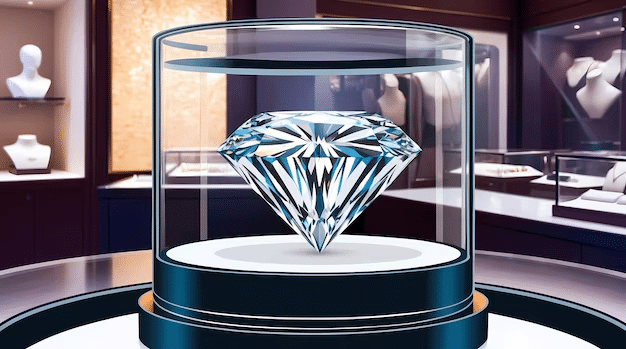- by Majid Jahangir
- October 29, 2024
The diamond industry is about to change a lot. A new focus on honesty is changing how diamonds are bought, sold, and viewed.
More people want ethical diamonds. They care about where their diamonds come from and want to know they are sourced responsibly.
Lab-grown diamonds are also significant. These diamonds are produced in labs and are environmentally much better. They provide an even clearer and more ethically viable route to source diamonds than through traditional mining methods.
What does this spell for the diamond industry? How will increased transparency change how people view diamonds and their value?
This article looks into these questions. We will discuss the future of diamond transparency and what it means for buyers, businesses, and the global diamond market.

The Demand for Ethical Diamonds
Consumers are changing the diamond industry. There is a growing interest in ethical diamonds. These diamonds are made without harming people or the environment. This change shows that consumer values are shifting.
Social media and online platforms give consumers a louder voice. People can now ask for honesty and fair practices from diamond sellers. As more people become aware, companies are changing to meet these needs.
Ethical diamonds are not just a trend; they are necessary. Today’s buyers want to be sure that their purchases come from responsible sources and fair work conditions. This is changing how businesses buy and sell diamonds.
Retailers must now show proof of ethical sourcing. If they don’t, they might lose trust and customers. This demand is pushing the industry to quickly become more open and honest.
The rising need for ethical diamonds is causing big changes. It is creating a market where being transparent is key for future success. Consumers are leading the way for a more responsible diamond market.
Blockchain Technology: The Revolution Edge in Diamond Tracking
Blockchain is altering the way diamonds are traced. Every step of the diamond, from mines to stores, is recorded in the blockchain. It will ensure that there exists a transparent and unchangeable record, thus forming trust between sellers and buyers.
The diamond industry gets much from blockchain’s clear record-keeping. People can check where a diamond comes from, making sure it meets good ethical and environmental standards. This helps hold the supply chain accountable.
Some of the key benefits of blockchain in tracking diamonds include:
A record that cannot be changed, preventing fraud.
More trust from consumers due to clear sourcing.
Better adherence to ethical standards throughout the supply chain.
Blockchain also helps with checking for conflict diamonds. With detailed records of each diamond’s path, it is easier to spot and avoid conflict diamonds, promoting a more ethical market.
Overall, blockchain fosters greater openness. And as the technology spreads, it can change how the industry about diamonds will function.
Lab-Grown Diamonds: A Sustainable Alternative
Lab-grown diamonds have gained popularity recently for their sustainability in comparison with mined ones. They are made in labs and are absolutely like natural diamonds. Their popularity is based on their ethical and environmental benefits.

Lab-grown diamonds use fewer resources to make. They are better for the environment because they don’t need mining, which can harm the land. This makes them a good choice for people who care about the planet.
These diamonds also offer more clarity in the market. Since the origin of their source is known, customers can confidently get these without the conflict-related issues that may be attributed to mined diamonds. Most consumers are embracing these responsible alternatives as they become educated about them.
The market for synthetic diamonds is growing fast. They are cheaper than natural diamonds, which draws in bargain shoppers. As technology improves, these diamonds will likely become even more popular.
As the diamond business changes, lab-grown diamonds will play an important part. They fit with today’s values of sustainability and ethics, making for a bright future in diamonds.
The effect of transparency on diamond value
This translates into a different face concerning diamonds and their value. It is when people are conscious of its origin and ethical source, then they trust it better. This makes it look more attractive and, in turn, more valuable.
Transparent diamonds may cost a bit more. Customers are paying an extra premium for that comfort of knowing the diamond comes from an ethical source.
There are also highly luxurious products like diamonds which are now more scrutinized. Their customers demand an ethical source. The diamond with known origin is better for the customers.
Diamonds’ look is now changing. The source of diamonds now matters. The source being traceable is a good choice. This trend in the industry will change its course, and the company needs to make clear sourcing a priority.
Challenges of Traditional Mining
Traditional diamond mining lacks transparency. The supply chain is complex. Diamonds go through many hands, which makes it hard to track the journey.
In regions where conflict diamonds are sourced, it is even more challenging to achieve transparency. Such regions lack regulation, which makes ethical sourcing difficult.
Traditional mining also harms the environment, creating more ethical concerns. Miners must find a way to operate responsibly while being clear about their practices.
Improvements in transparency in mining are being made. New technologies and certifications are coming to make the supply chain clearer, ensuring ethical sourcing.
Social Media and Consumer Activism
Social media plays an important role in changing the way diamonds are sourced. Consumers have strong voices that can ask for more transparency, putting pressure on the diamond industry.
Activism is pushing for ethical practices throughout the supply chain. Companies must respond quickly to these demands.
This change is transforming the market. Due to consumer pressure, companies are adopting clearer practices. The discussion now includes transparent diamonds, showing how consumer voices matter.

Global Standards for Transparency
Global standards and certifications are key for diamond transparency. They set rules for ethical sourcing. These standards ensure that diamonds meet certain ethical and environmental guidelines.
Many initiatives help shape the industry. The Kimberley Process works to stop the trade of conflict diamonds. Similar systems help build trust by guaranteeing where diamonds come from.
Important certifications for diamond transparency include:
Kimberley Process Certification Scheme (KPCS)
Responsible Jewellery Council (RJC) Certification
Fair Trade Diamonds Certification
These certifications support transparency and sustainability, guiding companies toward ethical practices. When consumers see these labels, they know the sourcing is responsible.
Global standards are essential for keeping consumer trust. They show the industry’s dedication to ethics and accountability. As demand for transparent diamonds increases, these certifications will become even more important.
Changes in What Consumers Want and Market Trends
Consumer tastes in the diamond market are changing fast. People now prefer diamonds that are ethical and transparent. This change is affecting how the market operates.
Traditional diamonds are not as appealing as before. More buyers choose lab-grown diamonds because they are eco-friendly. These diamonds offer a sustainable option compared to mined diamonds.
The consumer is better informed about the origin of their diamonds. This is increasing demand for honest sourcing practices. Thus, buyers are more attracted to the brands that are transparent.
The Role of Governments and Global Groups in Regulation
Diamond transactions should be made transparent with the leading role played by governments.They set rules to protect both buyers and the environment. These rules help stop the sale of conflict diamonds.
New technologies and checking diamond origins are very important in this context.
New technologies change the diamond industry. One player in the change is blockchain. It means a diamond can be tracked much more accurately.
Currently, every diamond has a digital record of where it comes from. This openness builds trust with buyers about their diamonds. Technology makes sure that there’s ethical sourcing and that it’s actually a product.
Other technologies, such as laser engraving, back blockchain by stamping diamonds. These engravings carry unique identifiers, tracking every diamond. All these innovations help sort out conflict diamonds.
This technology shift will provide consumers with more information. Provided with verified origins, a consumer can make better decisions. This will promise the market to be fair and clear.
Conclusion:
The diamond industry is changing a lot. Transparency is key to tackling ethical and environmental issues. Lab-grown diamonds and new technologies are central to this shift.
Consumers are more aware and careful than ever.They want to know whether their diamonds are sourced ethically and sustainably. Such demand is forcing the industry to change.
With increasing transparency, the diamond market would have to adjust to meet the new norms. Transparency, ethics, and value will make the industry far more equitable and sustainable for the future.
